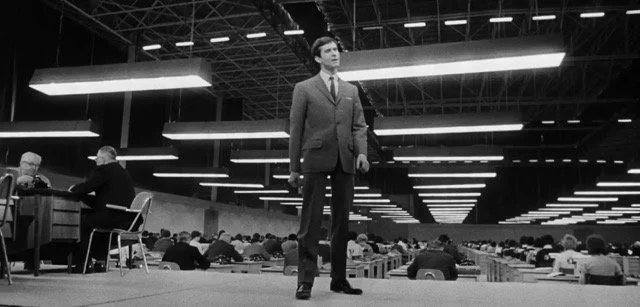Time Is the Enemy in (and of) A House of Dynamite
The most haunting question in Kathryn Bigelow’s A House of Dynamite is almost a throwaway: “We did everything right, right?” But the man voicing that question never had the tools or the power to do what was right to prevent this situation: he was only dealt a couple of cards that never could win a hand. Holding those cards, though, inclines him to assume responsibility and guilt. It’s an injustice baked into an atrocity.
A House of Dynamite is about how easily everything can go wrong, even when everything works as it should. Bigelow’s film focuses on the institutions of government (the military, FEMA, the presidential cabinet and advisors) as they respond to the appearance of a nuclear missile heading for a major US city. A mundane day is turned into a cataclysm, a day of potential disaster, and they scarcely have twenty minutes to prevent that disaster from occurring.
A grand, tense setup, but the resulting movie is a bit of a hodgepodge: it features a collage of characters driven by strong performances from Rebecca Ferguson, Jared Harris, Gabriel Basso, and Tracy Letts, but the jumbled techniques achieve only a muddled effectiveness, and the structure gradually chips away at the tension. The first thirty or so minutes are irreproachable as we are introduced to the situation through the eyes of Olivia Walker (Ferguson), who works in the White House Situation Room. What seems a glitch or an errant exercise—an annoyance—soon crystallizes the room’s attention as they confront the weight of this moment. As the clock ticks away and the missile approaches, Walker and others scramble to deter the missile and determine its origin. The section is rattling, and as the seconds wind down the screen cuts to black, distancing us from the finality of whatever has occurred.
The film then jumps backward, resetting the clock to provide us the perspective of others: Basso’s Nate Baerington, the Deputy National Security Advisor, who’s attempting to avoid a destructive retaliation; Ana Park (Greta Lee), an expert on North Korea’s military capabilities; Secretary of Defense Reid Baker (Harris), whose daughter might be in the path of the missile; and others. There’s a clear purpose to the method here—Bigelow’s attention to detail prioritizes the strain of having to confront this situation in real time—but simply showing the same span of twenty minutes from a few sides removes much of the tension. We know that strategy will fail, we know the choice this character will make and how others will respond to it. Some information is added, but never significant weight. By the end of the film, the torment of the first third is a distant memory, and what remains feels like mere exercise. Time is ultimately the enemy of the film, itself.
The individual techniques of scenes are also muddled. The film keeps us close to the characters; we only know what they know, when they know it, which inserts us into the panic of the situation. Bigelow taps into the fact that staring at a monitor as disaster unfolds is one of the most helpless feelings. But being an audience member, watching someone else stare at that screen, significantly weakens that. Likewise, zooms into screens don’t have the crashing impact they’re intended to, as the contents on the monitors don’t have an intuitive meaning for us. These cinematographic choices clearly want us to be shaken, but the audience is a bit too distanced for it to hit home. Most bizarre and ineffective is the decision to withhold the image of the president—though we’ve already heard his voice—revealing him finally as though he’s a Bond villain.
For these strained aspects, however, there’s still a power (if partial) to A House of Dynamite. There is no good option—the best option is to never have played this nuclear game in the first place. But here we are, in the middle of it. To make matters worse, the movie offers us a landscape of competent institutions in its depiction of the Army, White House Situation Room, FEMA, and the press. Institutions that, though they never lived up to their intended ideals, have been decimated and compromised throughout the year. Some have seen Bigelow’s depiction as naïve or even propagandistic, but these portraits also carry a critique of their own: If the world would be this close to destruction even if these all act so responsibly, then how thin is our security in the real world? The movie isn’t inserting this ideal as though it’s reality; rather, it drives home the disparity between the two.
Ultimately A House of Dynamite is concerned about the failures of the past—much like One Battle After Another, though Paul Thomas Anderson’s film is fierier and altogether more invigorating. The global powers waned in their commitment to nuclear disarmament, and we hang now by a thread. We return to the injustice of that question. “We did everything right, right?” Characters are made to feel their failure in a world where such failure was inevitable, where disaster was all but guaranteed. Those who had the ability to actually achieve the “right” outcome chose destruction long ago. The characters in A House of Dynamite are picking up a game that someone else started, and now it must be played to the end.



